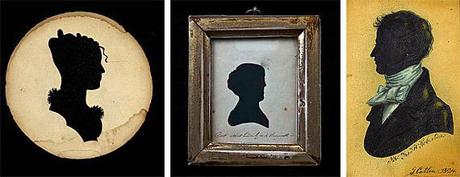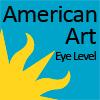This post is the first of an ongoing series on Eye Level: "Q and Art" and is the successor to our series "The Best of Ask Joan of Art." Begun in 1993, Ask Joan of Art was the longest-running arts-based electronic reference service in the country. We retired the service late last year but want to continue to bring you interesting questions and answers about art and artists from our archive.

Left: an unidentified artist's hollow-cut silhouette of Evelyn Byrd, center: M. A. Honeywell's cut-and-pasted silhouette Lady, right: George Catlin's painted silhouette Mr. Fred H. Robinson
Question: I heard that the term silhouette comes from the name of the 18th century French finance minister Etienne de Silhouette. What is the history of silhouettes in the United States?
Answer: Silhouettes were a popular art form in the United States in the 18th and 19th centuries because they were accurate, inexpensive, quick to make and easy to send to a friend or relative. Scholars believe Etienne de Silhouette’s name became connected with these black and white portraits because of the finance minister’s extreme cost-cutting. Referring to his penny-pinching efforts, affordable items were often labeled à la Silhouette. Earlier names for silhouettes included shades, profiles or shadow pictures. The more sophisticated sounding "silhouette" was popularized in the United States and England by European artists who wanted to make their portraits stand out from the shades that were already common.
The earliest known mention of a silhouette in America was in a 1769 letter from Harriott Pinckney: "Thos. Wollaston has summon'd me today, to put the finishing strokes to my shadow, which straightens me for time." By the end of the 18th century silhouettists had established studios in cities, and many traveling silhouettists offered their services to smaller towns. Artists distinguished themselves from the competition through advertisements in the local newspaper that promoted the artist's speed, accuracy and innovative technique. While some artists used only scissors and possibly paint to create their clients portraits, many others employed a mechanical device, known as a physiognotrace, to trace and simultaneously reduce the sitter's profile. Beginning in 1802, Charles Willson Peale placed a physiognotrace in his Philadelphia museum. Visitors could use the device themselves or pay Moses Williams, Peale's slave, to operate the physiognotrace for them. The device was an enormous success, and more than 8,500 silhouettes were cut in the first year. Williams made enough money from the service to buy his freedom.
As photography became more common in the mid 19th century, silhouettes fell out of fashion. Photographs shared and improved on many of the benefits of silhouettes. However, despite photography's triumph over the older art form, we still see the influence of these simple portraits in the decorative arts and the work of contemporary artists such as Kara Walker.
Silhouettes in the United States (and in the American Art Museum's collection) are divided into three main types: painted, hollow-cut (profile cut from the center of a sheet of light colored paper and placed over a dark ground), and cut-and-pasted (profile cut from black paper and pasted onto a white ground).
For more information on silhouettes, look for Emma Rutherford's and Lulu Guinness's book Silhouette: The Art of the Shadow.

